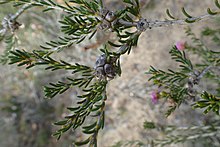| Melaleuca villosisepala | |
|---|---|

| |
| Scientific classification | |
| Kingdom: | Plantae |
| Clade: | Tracheophytes |
| Clade: | Angiosperms |
| Clade: | Eudicots |
| Clade: | Rosids |
| Order: | Myrtales |
| Family: | Myrtaceae |
| Genus: | Melaleuca |
| Species: | M. villosisepala |
| Binomial name | |
| Melaleuca villosisepala Craven | |


Melaleuca villosisepala is a shrub in the myrtle family Myrtaceae and is endemic to the south-west of Western Australia. It is a shrub with narrow leaves, heads of pink to mauve flowers that fade to white and is similar to Melaleuca wonganensis except that its heads of flowers are smaller and pinkish rather than deep purple.
Description
Melaleuca villosisepala grows to a height of 0.2–1.3 m (0.7–4 ft). Its leaves are arranged alternately and are 3–15 mm (0.1–0.6 in) long, 0.5–1.5 mm (0.02–0.06 in) wide, linear to oblong, silky-hairy at first but becoming glabrous as they age.
The flowers are arranged in heads about 20 mm (0.8 in) in diameter, near the ends of the branches, with one to six groups of flowers, each with three individual flowers. The base of the flowers is hairy, 1.5–3 mm (0.06–0.1 in) long and the stamens are arranged around each flower in five bundles, each containing 5 to 9 stamens. The flowers are pink or mauve and fade to white and from September to February. The fruit are 2.5–4.5 mm (0.1–0.2 in) long.
Taxonomy and naming
Melaleuca villosisepala was first formally described in 1999 by Lyndley Craven in Australian Systematic Botany. The specific epithet (villosisepala) is derived from the Latin word villosus meaning "hairy" and the Neo-Latin word sepalum meaning "sepal", referring to the hairy lobes of the calyx.
Distribution and habitat
This melaleuca occurs from the Southern Cross-Coolgardie districts, south to the Stirling Range-Ravensthorpe districts in the Esperance Plains biogeographical zone. It grows in red-brown clay-loam, often in roadside remnant vegetation.
Conservation
Melaleuca villosisepala is classified as "not threatened" by the Government of Western Australia Department of Parks and Wildlife.
References
- "Melaleuca villosisepala". Plants of the World Onoine. Retrieved 14 September 2021.
- ^ Holliday, Ivan (2004). Melaleucas : a field and garden guide (2nd ed.). Frenchs Forest, N.S.W.: Reed New Holland Publishers. p. 226. ISBN 1876334983.
- ^ Brophy, Joseph J.; Craven, Lyndley A.; Doran, John C. (2013). Melaleucas : their botany, essential oils and uses. Canberra: Australian Centre for International Agricultural Research. p. 377. ISBN 9781922137517.
- "Melaleuca villosisepala". APNI. Retrieved 12 March 2015.
- Craven, L. A.; Lepschi, B. J. (1999). "Enumeration of the species and infraspecific taxa of Melaleuca (Myrtaceae) occurring in Australia and Tasmania". Australian Systematic Botany. 12 (6): 915. doi:10.1071/SB98019. Retrieved 12 March 2015.
- ^ Brown, Roland Wilbur (1956). The Composition of Scientific Words. Washington, D.C.: Smithsonian Institution Press.
- Paczkowska, Grazyna; Chapman, Alex R. (2000). The Western Australian flora : a descriptive catalogue. Perth: Wildflower Society of Western Australia. p. 398. ISBN 0646402439.
- ^ "Melaleuca villosisepala". FloraBase. Western Australian Government Department of Biodiversity, Conservation and Attractions.